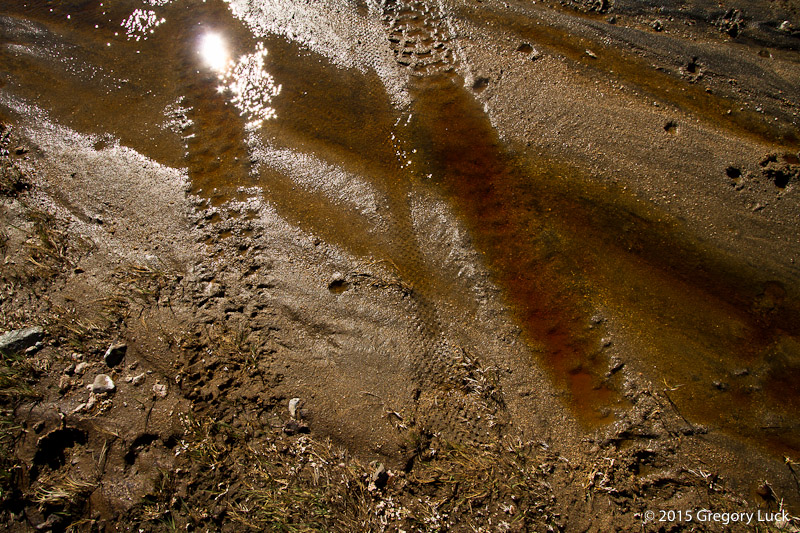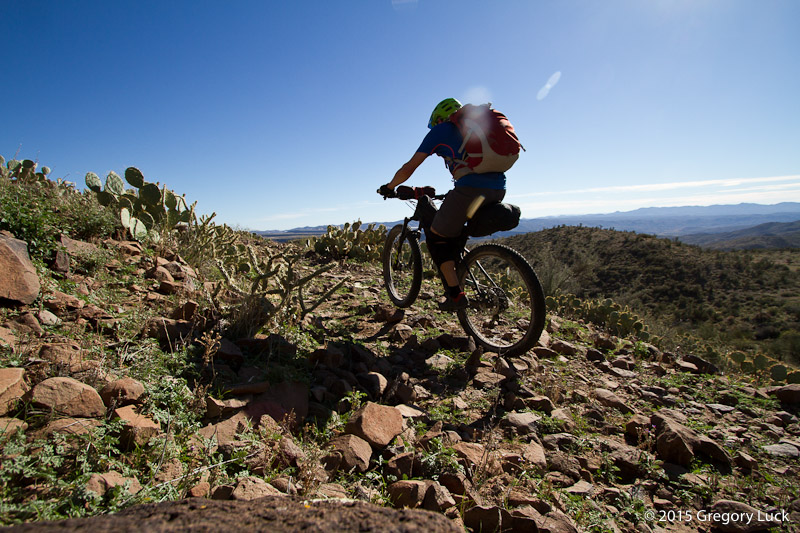
by Greg
I don't always do things the proper way. Or even choose to do the proper things. Hot springs in slot canyons on the Colorado River below Hoover Dam in February? That had a nice sound to it. And an 11 mile canyon float? Even better.
Here's how it's done: Pay a livery service to a) Perform a background check on you and b) take you and your canoe/sea kayak/power boat to the base of Hoover Dam. Expect crowds. Float a short way to the slot canyon, hike up and soak. Get back in your boat and float to another slot canyon with a hot spring. Hike up and soak. Expect crowds. Maybe camp on the beach with a crowd. Then paddle/motor on down the canyon to the take out. Yay!
And here's how I did it: Convince Trina that I have a good plan and that it will be fun, even though I really have no idea what I'm doing. Drop Trina and the dogs and packs off at the top of a slot canyon near Hoover Dam. Drive to the take out and spend a long, long time trying to hitch the shuttle with fearful RV retirees, ritzy Vegas day-trippers, and foreign travelers who aren't headed back toward the dam, then finally a (foolish?) high school girl with a plastic kayak picks you up. Think about lecturing her about the dangers of picking up hitchhikers, but don't say anything because you really need the ride.

Start hiking down the slot canyon with big packs, rafts, paddles and two dogs. It's a popular hike and people wonder what you're doing, but by this time it's late afternoon and everyone else is leaving. Realize that the slot canyon is somewhat more technical than expected, with ladder steps cut into the rock and sketchy rope descents that require lowering down packs and dogs.



Find water flowing in a slot canyon, which is always wonderful, but especially wonderful if the water is warm. Find that there is more and more water and warmer and warmer water as you descend. Find that the day is over and it is twilight. Reach the river and a small stony beach that's not quite level enough to camp on. Do not leave your packs here. Instead, leave them on a small rocky promontory that reaches out into the river, while you wade across the shallow stream and back up the canyon to soak in the pools. Sigh with gratitude and relief at the comfort of the warm water and the fact that these natural pools are heavily sand-bagged to make them deeper and that there is no one else here to share them with you.



Filled with contentment, stroll back down toward the beach and find that the river has risen by a couple feet and the shallow stream you waded across is now a bay that requires more than wading. The beach is gone. Now that you think about it, you recall hearing something about the dam releasing more water at night when it's generating more electricity for the lights of the nearby city.
The packs are still above the water, but for how long? Do you camp on the high point of the rocky promontory, or on a shelf on the cliff-side, or go back up the canyon and try to find a flat and dry spot in a wet slot canyon where you can sleep? Try the shelf. But keep everything unnecessary packed while you cook and then prepare to sleep, in case you have to grab it all and scramble up the rocks where there isn't anywhere to lay down, but at least you wouldn't get all wet and maybe drown.

Sleep a nervous sleep above the possibly rising water in this wild place below the dam and below the noisy and streaming traffic on the bridge high above you.
In the morning prepare the coffee, or nothing else will matter (to Trina). The water is down. The beach is back. Inflate a packraft, throw a dog on the bow and push out into the current. Enjoy the dark canyon walls and the clear, green water. Enjoy the colorful kayaks and friendly kayakers who are sharing the river with you. Enjoy the convulsing canyon air as the first helicopter tour of the day flies overhead toward the dam. Enjoy the cactus-covered walls, the convoluted geology, the steady current (enjoy this more than you think you need to) and keep enjoying the helicopters, because they'll be with you most of the day. The current will not.




Paddle past secret palm tree oases. Watch coyotes hunting on the banks of the river. Pull up on a beach with a dozen or more kayaks. Hike a narrow canyon. Scramble up a rocky slot over a stream of warm water. Climb a tall steel ladder with a dog under your arm.





Quietly greet the nice people sitting in the sandbagged pools. Couples. Families with children. A desert rat or two. Try not to stare or glare though some of the people seem to be taking semi-raunchy bikini photos amid the small crowd. Enjoy the neck-deep warmth of the water and keep nodding occasionally as the man near you keeps talking and talking, making sure you understand the immense size of his fiscal "wickerbill" while his (probably much, much smaller) actual "wickerbill" remains thankfully inside his swimsuit. Nod, close your eyes and dream that you are a Native American who has discovered these wild pools and that you are here all alone with just your fine, strong woman and two trusty dogs and no helicopters.

Go back to the rafts and get back in the river before realizing that the river is gone and has been replaced by a long narrow lake that is backing up behind the next dam downstream. Begin to paddle along the flat water in the lovely canyon. Explore a small cave at water level. Continue paddling the flat water in the canyon. Paddle some more. Watch canoes pass you by. Keep paddling the flat water in the stupid canyon as midday turns to afternoon and begins to become evening. Wonder why you are in a dumpy little raft instead of a sleek sea kayak or canoe or powerboat or even a damn helicopter.


Thank your lucky stars that there is no wind trying to push you back up the canyon. Stretch your aching arms and paddle some more. Then, finally, beach the raft and flop exhausted onto the wet sand of the take out.

Heap everything into the truck and drive away just before the sun dips behind the canyon walls.
The wrong way? Maybe. But we got to see a cool area, even if we prefer our adventures to be more solitary. And we also got to remind ourselves that packrafts are good for many things, but flat water isn't really one of them. And this probably isn't the last time we'll do things the wrong way. And enjoy it anyway.














